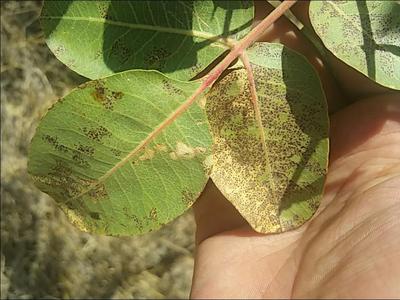Leaf Spot of Pistachio
Pseudocercospora pistacina
Fungus
5 mins to read
In a Nutshell
- Dry brown spots on both sides of the leaflets.
- Paling or browning of the blades, gradually extending towards the midrib.
- Withering of leaves and premature fall.
Can also be found in
Symptoms
The disease causes circular to irregular necrotic spots, brown to dark brown in color, on both sides of the leaflets. On leaves, these spots may become very numerous and reach in 1 to 2 mm in diameter. Over time, the leaf blade gradually turns pale green and later brownish, starting from the margins and extending towards the midrib. Heavy infestations can cause leaves to wither and fall prematurely. Very small spots may also form on the fruits. Severe epidemics of this disease can cause premature defoliation and reduce tree vigor. The onset of attacks generally begins in April from the inoculum found in the leaf litter of the past year.
Recommendations

Organic Control
At the first symptoms, sprays with copper or sulfur-based products. Applications must take place after fruit have reached about 1 cm in size to avoid phytotoxic damage to very young fruit.

Chemical Control
Always consider an integrated pest management with preventative measures and biological treatments if available. From the appearance of the first spots, spray 2 or 3 times with products containing the active ingredient thiophanate-methyl. Treatments with fungicides based on zineb, mancozeb, chlorothalonil or copper fungicides are also effective, but must be applied after fruit have reached 1 cm size to avoid phytotoxic damage to very young fruit. Alternate the different active ingredients to avoid the development of resistance. Preventive treatments from bud break are also effective to prevent the appearance of the disease.
What caused it?
The symptoms are caused by several fungi of the genus Mycosphaerella, in the Mediterranean area mainly M. pistacina. It overwinters in fallen leaves on the soil litter that were infected while on the tree in previous seasons. Primary contamination is through the fungal inoculum from these leaves. Rain splashes help in the dispersal of the spores. Secondary infections are caused by other type of spores which are also spread by rain or sprinkler water, until late in the season. High temperatures between 20 and 24 ° C, humid climate and fog are favorable conditions for the propagation and the multiplication of the pathogen.
Preventive Measures
- Inspect the orchard regularly to detect the appearance of the first spots.
- Collect fallen leaves and incinerate them.
- Fertilize the trees or enrich your soil with organic matter to improve the natural resistance of plants.
- Plan a regular pruning every year during the dormant time to get good ventilated canopies and reduce the risk of infection.
- Clean orchard and surroundings of alternate host plants and weeds.
- Do not touch diseased plants in wet weather to prevent the spread of the pathogen.
- Do not use sprinkler irrigation systems.
- Buried dead leaves by deep plowing in late fall and early winter.


